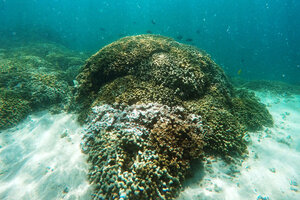What's killing Hawaii's coral reefs? Aquariums, say some experts
The 50th state has announced the aquarium fishery trade can continue without further regulation, despite pleas from organizations and agencies to curb aquarium collecting for the reefs' sake.

In this Oct. 26, 2015 file photo, fish swim over a patch of bleached coral in Hawaii’s Kaneohe Bay off the island of Oahu. State officials are outlining a management plan for Hawaii's coral reefs, which have suffered a second consecutive year of damaging bleaching. Experts are worried continued stress could kill portions of the reef which are critical parts of the ecosystem and the state's tourist economy.
Caleb Jones/AP
In November, the Hawaii Department of Land and Natural Resources confirmed an upcoming comprehensive coral reef management plan, in an effort to combat the extensive bleaching of Hawaii’s reefs.
But two state agencies, 16 environmental groups, and the majority of Hawaii’s residents feel the plan is pointless because it intentionally ignores a crucial aspect of reef management: the aquarium fishery.
Hawaii is the biggest provider of fish for the US aquarium trade, with hundreds of thousands of fish shipped to the mainland to be sold in pet stores. Seventy percent of aquarium fish caught statewide come from the Kona coast. The amount of fish caught in the aquarium collection trade is almost twice as many animals caught in Hawaii in subsistence, recreational, and food fisheries combined.
“We have a lot of in-depth monitoring going on,” William Walsh, an aquatic biologist with the state, tells The Associated Press. “Banning aquarium collecting would have zero effect.”
But the State Office of Environmental Quality Control and members of the state Environmental Council issued a letter to Gov. David Ige and Department of Land and Natural Resources (DLNR) Chair Suzanne Case last month asking for an emergency moratorium on the collection of reef wildlife for aquariums because of unprecedented coral bleaching in Hawaii.
And while details of the management plan have yet to be published, officials said Monday they will not impose an emergency moratorium on fishing for aquarium collection.
“It’s very irresponsible and it's very short sighted,” Igna Gibson, the Hawaii state director of the Humane Society, tells The Christian Science Monitor in a phone interview Tuesday. “The number one thing that coral reef managers must do during these types of natural disasters is protect the herbivores. They keep reefs free of algae, which exacerbates bleaching.”
Multiple calls to Hawaii's DLNR were not returned.
Critics of the moratorium request say it only serves animal welfare objectives and had nothing to do with coral bleaching.
“You can’t reason with that. It’s a moral position,” Matt Ross, an aquarium fish collector on the island of Oahu, tells the Honolulu Civil Beat. “As a fisherman and someone who really does care about conservation, it’s really frustrating.”
But Ms. Gibson argues moratorium supporters really are just thinking about the reefs.
“This is not an animal welfare issue,” she tells The Monitor, “This bleaching event means the state needs to take all necessary steps to protect the reefs. A six-month moratorium would let us get much more information, and finally do an environmental assessment [on the aquarium fish trade] which has never been done in its 50-year history.”
She adds, “No one is saying that the aquarium trade is causing bleaching. Bleaching has to do with ocean temperature rise, so we have to take all the other steps we can to protect our reefs.”
In a recent DLNR press release, Ms. Case confirmed that herbivores, which make up 92 percent of the aquarium catch, have increased in Hawaii waters and collectors catch only five parrotfish each year.
Ms. Gibson does not disagree, but she says these statistics are irrelevant. She says the state fails to add that population growth is only evident in protected areas, whereas the population of popular Yellow Tangs, for example, are down 90 percent.
“We don’t dispute that parrotfish are important. But why would the state exclude all these other kinds of fish that are being taken?” she asks. “We need to look at all herbivores, they are all algae eaters and they are all apart of a larger ecosystem.”

